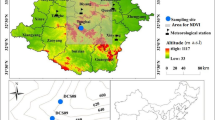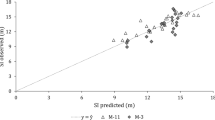Abstract
The objectives of this study were (1) to evaluate the effects of environmental factors derived from GIS on tree-height growth of Japanese larch (Larix kaempferi) and (2) to develop a best-fit regression model for its site index. Based on data from 40 sample plots situated in an even-aged (38 years), pure, and undamaged Japanese larch stand, multiple regression models for a site index of Japanese larch were constructed using environmental factors as independent variables. The average slope gradient, effective relief, distance from ridge, flow accumulation, degree of exposure, shading, solar radiation index, and gravitational water index were used as environmental factors and calculated on GIS using digital elevation model data. These factors were related to the Japanese larch site index through multiple-regression analysis. The result showed that the most effective factor for estimating site index was the degree of exposure. Through a backward stepwise procedure, the degree of exposure, shading, and average slope gradient were selected for a best-fit regression model. This model explained 72% of the variance in site index, with standard error estimates of 1.75 m. This strong relationship suggests that GIS-derived environmental factors can be used to predict site indices of Japanese larch.
Similar content being viewed by others
Literature cited
Blaszczynski, J.S. (1997) Landform characterization with geographic information systems. PE & RS. 63: 183–191.
Chen, H.Y.H., Klinka, K., and Kabzems, R.D. (1998) Site index, site quality, and foliar nutrients of trembling aspen: Relationships and predictions. Can. J. For. Res. 28: 1743–1755.
Chen, J. and Abe, N. (1999) Site classification for sugi plantation using GIS. J. For. Plann. 5: 1–8.
Corona, P., Scotti, R., and Tarchiani, N. (1998) Relationship between environmental factors and site index in Douglas-fir plantations in central Italy. For. Ecol. Manage. 110: 195–207.
Cressie, N. (1990) The origins of kriging. Math. Geol. 22: 239–252.
Davis, L.S. and Johnson, K.N. (1987) Forest management, 3rd ed. 790pp, McGraw-Hill, New York.
Fox, L., III, Brockhaus, J.A., and Tosta, N.D. (1985) Classification of timberland productivity in northwestern California using Landsat, topographic, and ecological data. PE & RS. 51: 1745–1752.
Fukushima, T., Takaki, J., Takeshita, K., and Takata, M. (1974) Stand analysis concerning height-estimation of forest-land productivity (forChamaecyparis obtusa Sieb. et Zucc). Bull. Fukuoka-pref. For. Exp. Stn. 23: 1–34. (in Japanese with English abstract)
Green, R.N., Mashall, P.L., and Klinka, K. (1989) Estimating site index of Douglas-fir (Pseudotsuga menziesii [Mirb.] Franco) from ecological variables in southwestern British Columbia. Forest Sci. 35: 50–63.
Iverson, L.R., Dale, M.E., Scotto, C.S., and Prasad, A. (1997) A GIS-derived integrated moisture index to predict forest composition and productivity of Ohio forests (U.S.A.). Land. Ecol. 12: 331–348.
Jenson, S.K. and Domingue, J.O. (1988) Extracting topographic structure from digital elevation data for geographic information system analysis. PE & RS. 54: 1593–1600.
Kayahara, G.J., Klinka, K., and Marshall, P.L. (1998) Testing site index-site-factor relationships for predictingPinus contorta andPicea engelmannii × P. glauca productivity in central British Columbia, Canada. For. Ecol. Manage. 110: 141–150.
Klinka, K. and Carter, R.E. (1990) Relationships between site index and synoptic environmental factors in immature coastal Douglas-fir stands. Forest Sci. 36: 815–830.
Klinka, K. and Feller, M.C. (1984) Principles used in selecting tree species for regeneration of forest sites in southwestern British Columbia. For. Chron. 60: 77–85.
Kubota, J., Fukushima, Y., and Suzuki, M. (1987) Observation and modeling of the runoff process on a hill slope. J. Jpn. For. Soc. 69: 258–269. (in Japanese with English abstract)
Kuo, W.-L., Steenhuis, T.S., McCulloch, C.E., Mohler, C.L., Weinstein, D.A., DeGloria, S.D., and Swaney, D.P. (1999) Effect of grid size on runoff and soil moisture for a variable-source-area hydrology model. Water Resour. Res. 35: 3419–3428.
Martin, G.L. and Ek, A.R. (1990) Measurement of the forest.In Introduction to forest science, 2nd ed. Young, R.A. and Giese, R.L. (eds.), 586pp, John Willy & Sons, New York, 254–276.
McNab, W.H. (1989) Terrain shape index: Quantifying effect of minor landforms on tree height. Forest Sci. 35: 91–104.
McNab, W.H. (1993) A topographic index to quantify the effect of mesoscale landforms on site productivity. Can. J. For. Res. 23: 1100–1107.
Monserud, R.A., Moody, U., and Breuer, D.W. (1990) A soil-site study for inland Douglas-fir. Can. J. For. Res. 20: 686–695.
Murakami, T., Teraoka, Y., and Imada, M. (2000) Calculation of topological factors and their accuracy evaluations with digital map 50-m grid published by the Geographical Survey Institute. Jpn. J. For. Plann. 34: 13–26. (in Japanese with English abstract)
Neter, J., Kutner, M.H., Nachtsheim, C.J., and Wasserman, W. (1996) Applied linear statistical models, 4th ed. 1408pp, Irwin, Inc., Chicago.
Nishizawa, M., Mashimo, Y., and Kawabata, K. (1965) Estimation method for site index by quantification. Bull. Gov. For. Exp. Stn. 176: 1–54. (in Japanese with English abstract)
Okaue, M. (1957) On the intensity of solar radiation on any slope. J. Jpn. For. Soc. 39: 436–437. (in Japanese with English abstract)
Teraoka, Y., Masutani, T., and Imada, M. (1991) Estimating site index of sugi and hinoki from topographical factors on maps for forest management. Sci. Bull. Fac. Agric., Kyushu Univ. 45: 125–133. (in Japanese with English abstract)
Usui, G. and Miyaki, M. (1991) An existent term of gravitational water at a site of slope as a height growth index of Todo-fir (Abes sachalinensis). Bull. Kokkaido For. Res. Inst. 29: 18–20.
Usui, G., Goshu, K., Terazawa, K., and Yamane, G. (1986) Relationship between site quality and topographic factors of Japanese larch in Tokachi region. Kojunai-kihou 64: 6–12. (in Japanese)
Wang, G.G. (1995) White spruce site index in relation to soil, understory vegetation, and foliar nutrients. Can J. For. Res. 25: 29–38.
Wang, G.G. and Klinka, K. (1996) Use of synoptic variables in predicting white spruce site index. For. Ecol. Manage. 80: 95–105.
Yamane, G., Usui, G., Goshu, K., Kikuchi, K., and Terazawa, K. (1990) Multivariate analysis of site factors on afforestedLalix leptolepis Gordon. Bull. Hokkaido For. Res. Inst. 28: 54–63. (in Japanese with English abstract)
Author information
Authors and Affiliations
Additional information
This study was supported by the experimental forest of Kyushu University.
About this article
Cite this article
Mitsuda, Y., Yoshida, S. & Imada, M. Use of GIS-derived environmental factors in predicting site indices in Japanese larch plantations in Hokkaido. J For Res 6, 87–93 (2001). https://doi.org/10.1007/BF02762493
Accepted:
Issue Date:
DOI: https://doi.org/10.1007/BF02762493




